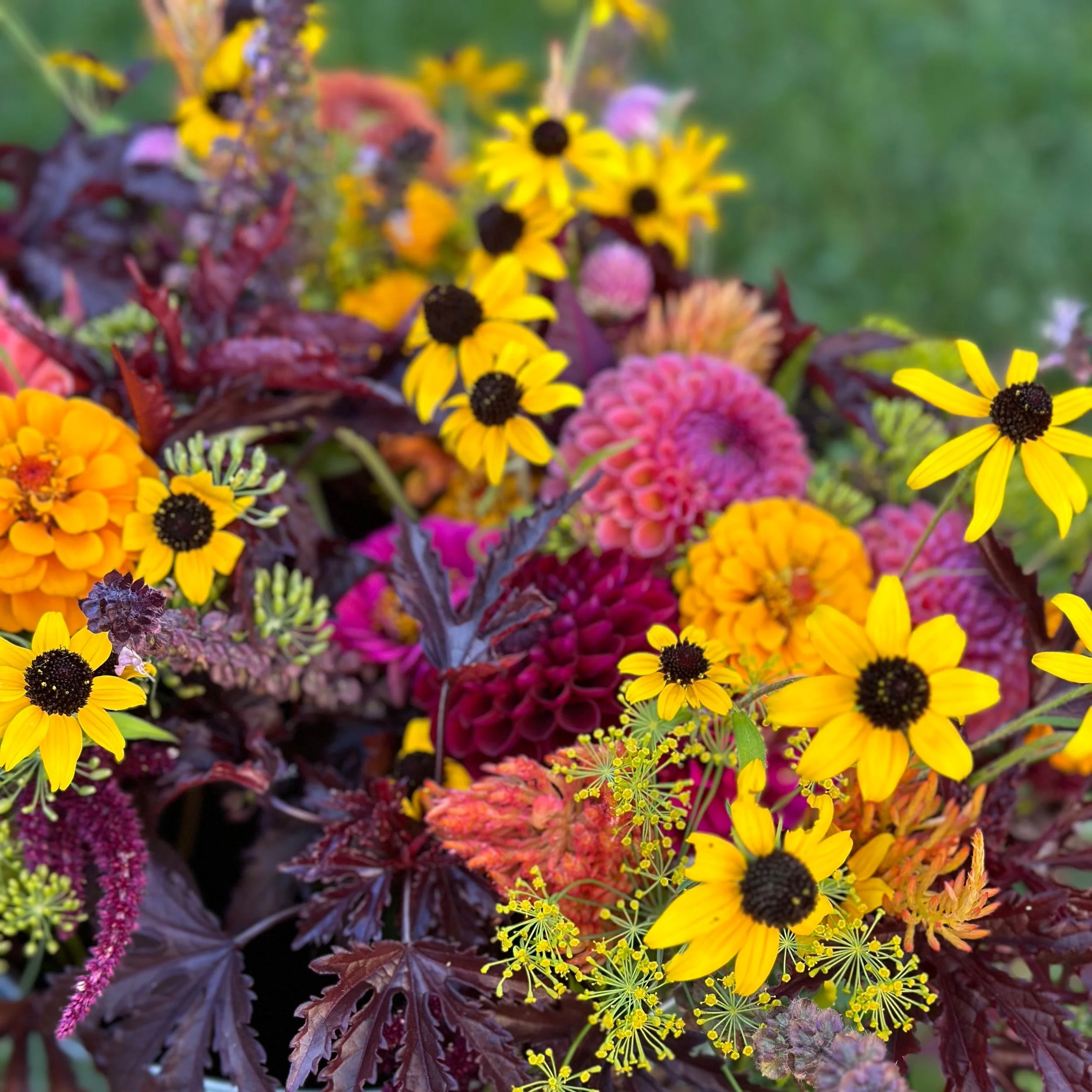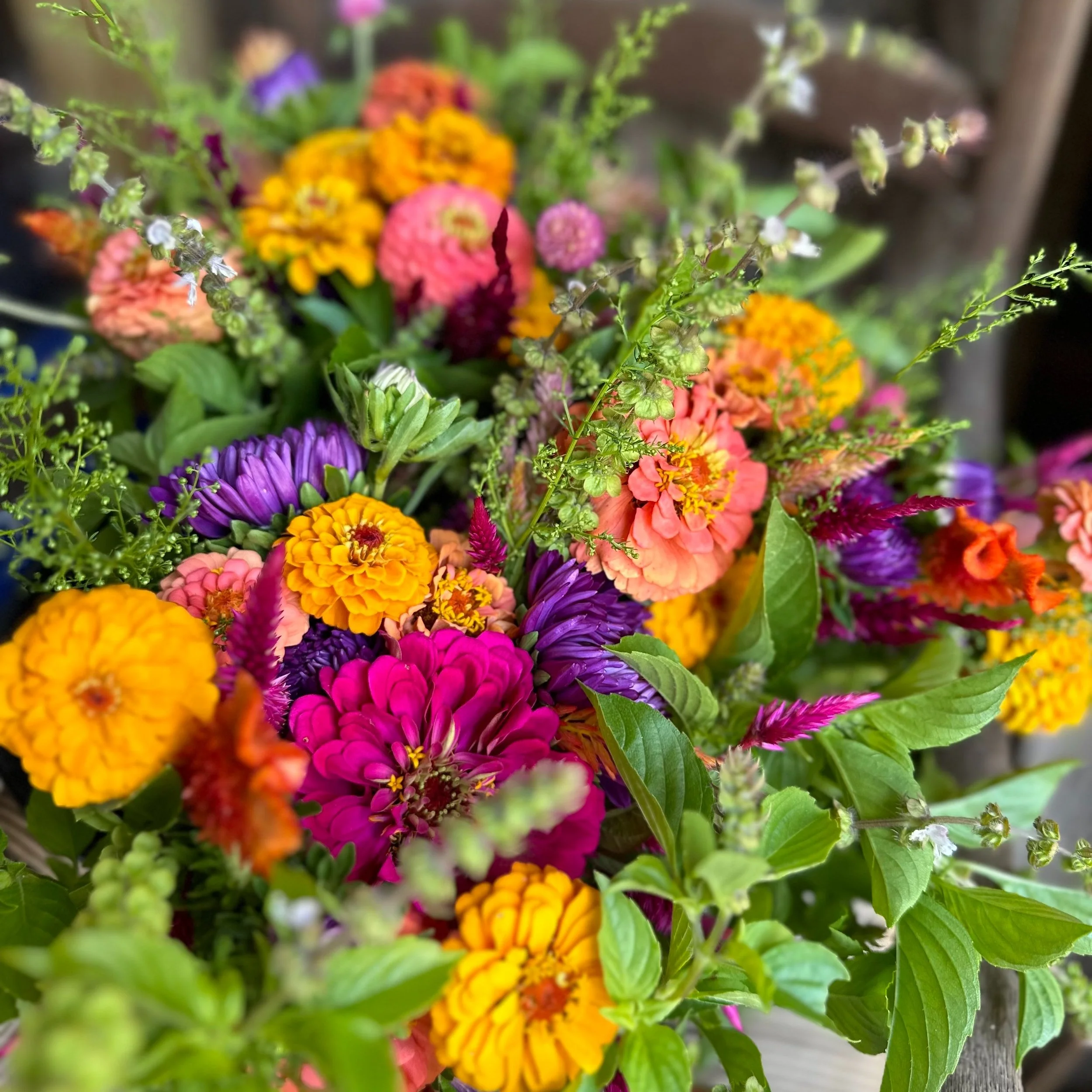Planning Your Cut Flower Garden
A Beginner’s Guide for a Season of Blooms
Growing a cut flower garden is one of the most rewarding ways to connect with nature. Whether you dream of filling vases in your home, gifting bouquets to friends, or simply soaking in the beauty of blooms in your backyard, creating a garden of your own is simpler than you might think.
Full disclosure, I decided to start this farm before I’d even grown a zinnia… and I mean, like… never had I grown a zinnia (or anything else from seed). Now, did I study up and research lots before I did so, yes, but do I think I really needed to do all of that… probably not.
My point is, gardening and growing is meant for experimentation. Plants want to grow… and most of the time nature knows exactly what to do (we humans are the ones who get in the way). So, if you’re ready to get growing (and going!) on your cut flower garden, I believe in you. Let’s dive in…
Why Start a Cut Flower Garden?
There’s something special about growing your own flowers. Are they beautiful? Of course. But it’s about so much more than that. It’s about the connection they bring: to others, to the land, the seasons, our creativity. Had I known how much inspiration I would find in the flowers, how much creativity, how many life lessons and chill moments and new friends I would make while out in the flowers, I would have started doing this decades ago.
There are a number of reasons to start a cut flower garden:
To add sustainable beauty to your home and decor (year-round!).
To create unique and personal gifts for people in your life.
To express yourself through color and design, or let it lead to other creative inspiration (especially if you like to do things like photography, drawing, painting or writing).
To feel a deeper connection to the natural rhythms around you and to honor the natural world and the lessons it has for us.
To be an active participant in caring for our planet (this one, especially).
If any of that sounds like something you’re craving, let’s start planning!
Choosing the Right Space
Location, Location, Location: Your flowers will thrive in the right spot (and subsequently dive if they’re not in the right spot). Ideally, look for a sunny area that gets at least 6-8 hours of sunlight daily. Most flowers love good drainage, so raised beds or well-draining soil are ideal. If space is tight, don’t worry—containers on a sunny patio work wonderfully, too. While I have land available to me for the farm, I also grow some flowers at my house tucked in alongside my garage. Get creative with your space!
Testing Your Soil: While not essential for beginners, if you’re growing directly in the ground a quick soil test can give you insights into what your flowers need. I send mine out to a lab because I want more detailed information about different amendments and such I can add to provide the most ideal growing conditions, but many garden centers offer affordable kits you can opt for if you’re curious. Or, you can also just dig a hole to get a general idea of the type of soil you’re working with. Is it sandy? Is it dark and dense? Full of clay? As a beginner, you’re just trying to get an idea of what you’re working with.
Deciding What to Grow
Start with the Basics: If this is your first cut flower garden, choose beginner-friendly blooms like the ones below (my easy cut flowers post has more details for each):
Zinnias – Bright, cheerful, and garden workhorses.
Sunflowers – A classic favorite with a big impact.
Cosmos – Delicate, airy flowers that grow easily.
Celosia – Amazing texture, lovely color variety and incredibly versatile.
Think About Purpose: Are you growing flowers for bouquets? Do you want a specific color palette for an event? Do you have plans to do something else with the flowers (like dry them, use them in crafts or herbal concoctions)? Or are you just exploring for fun? Keep your goals in mind when choosing seeds.
Factor in Your Zone: Understanding your USDA hardiness zone helps you pick plants that will thrive. For example, here in Michigan (Zone 6a), I lean toward hardy annuals (those that can stand some of the cooler spring and early summer temperatures) and summer bloomers. Given that I don’t have methods to extend my growing season (like a hoophouse or greenhouse), I’m looking for flowers that will thrive with the days as we move from spring to summer.
Planning Your Garden Layout
Keep It Simple: I repeat… keep it simple… please. There is nothing worse than being so excited about starting this process only to get down a rabbit hole to where you’re overwhelmed and not even sure what to do. Take it from an over-achieving perfectionist who often gets “paralysis-by-over-analysis” because of so much information and research. You don’t need a complicated design. I promise you. Rows, blocks, or even a mix of flowers in one large bed will work perfectly. Truth be told… I sort of wish the farm was a bit more random in design. But from an efficiency standpoint, long rows serve a purpose. Just give each plant enough room to grow… and have some fun with it!
Timing Matters: You’ve probably noticed that not all flowers bloom all summer long… although some certainly are workhorses. If you want to enjoy blooms all season, you either need to choose flowers that will do the heavy lifting for you, like “cut and come again” flowers. Or you’ll want to think about succession planting. Here’s a quick rundown:
Cut-and-come-again flowers: These are flowers that, the more you cut, the more they grow, and often will have blooms for weeks because of this. Zinnias and dahlias are examples of this.
Medium Producers: These are flowers that fall in-between. They’re productive, but they aren’t going to be AS productive as your cut-and-come-again ones. However, you’ll get additional flowers from them, unlike the one-offs.
One-offs: These are flowers that, once you cut them, there’s nothing else that will grow. Certain varieties of sunflowers are like this (the single-stem varieties I grow, for example). This means staggering your planting times or choosing varieties that bloom at different times.
Quick Tip: Remember when I said “keep it simple”, that comes in handy here, too. If you’re genuinely new to this, focus on cut-and-come-again ones… it will be far easier (and more enjoyable) because they’ll be stronger workhorses for you.
Don’t Forget Maintenance: We all love the beautiful flowers, but remember there’s some stuff that needs to happen in order to get to that point. You’d be surprised how many people want to help on the farm but when I mention that what I need help with is weeding, they’re not so inclined… I get it though… and I don’t blame them!
While I try to rely on Mother Nature as much as possible, flowers will still need regular watering, especially as they’re getting established outdoors. Consistent water is one of the main factors that goes into those long, strong stems that you want for cut flowers. Weeding and the occasional bit of care like deadheading (removing spent blooms) helps to keep them flourishing.
Now, a word on weeding. In some cases, weeds can actually be beneficial because they leave roots in the ground (a big plus when it comes to soil health). My goal is to always stay on top of weeding at the beginning of the season so that the flowers have a fighting chance, but towards the end of the season the weeds tend to take over. By that point though, the flowers are big enough where I’m not as concerned about it.
I share all of this because It’s important to think about maintenance ahead of time, especially as you’re planning things out. It is SO easy to get swept up into the seed catalogs and options (and I am 100% guilt of that), but the last thing you want your cut flower garden to do is stress you out because it’s taken over your summer life with an endless to-do list. Also, we all have different resources available to us. If you don’t have a lot of time during the summer, then you might want to start smaller so you don’t have to worry about wedding a massive garden. If you’re not in a spot that has easy access to water, you might want to think about how else you could set a garden up so that it’s a bit more accessible.
You Can Start a Cut Flower Garden… I Promise!
Starting a cut flower garden is less about perfection and more about finding joy in the process.
So even if you begin with just a few pots on your patio or a small raised bed in your yard, you’re creating something beautiful that connects you to the magic of the natural world, the cycles of life and the seasons we all go through. Remember, gardening is a journey of learning and growth—both for your flowers and yourself.
I have complete faith in your abilities… you can do it!
Ready to Get Growing?
Grab your copy of my Grow Your Own Cut Flowers guidebook! A simple, beginner-friendly guide packed with foolproof flower varieties, easy layouts, and practical tips to help you grow and harvest blooms all season long.




